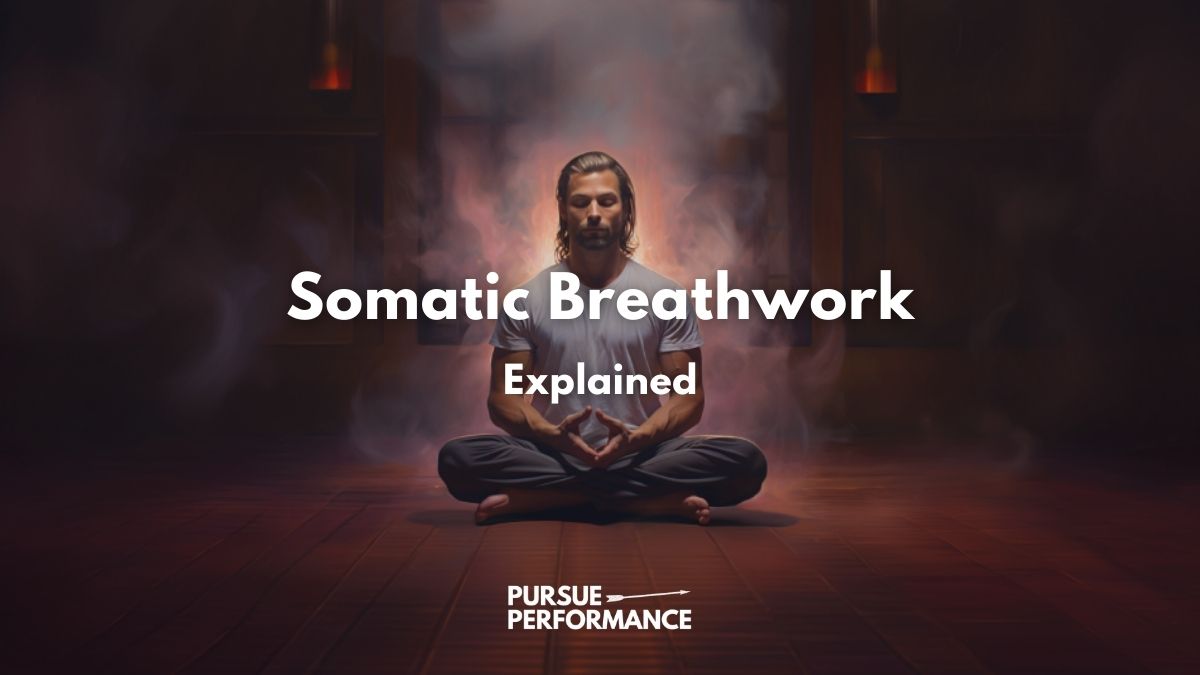Somatic Breathwork is a powerful tool that can support mental and physical health, promote healing, and foster a deep sense of connection to oneself.
By integrating it into your daily routine, you can tap into the profound healing power of the breath, experiencing enhanced well-being and holistic wellness.
And this isn’t just for yogis!
Somatic breathwork is a tremendous tool for athletes and high performers.
In this post, we will explain the concepts behind somatic breathwork and share some actionable practices to help you get started.
Let’s get into it!
What Is Somatic Breathwork?
Somatic breathwork is a potent combo of conscious breathing and body awareness.
It’s a holistic method designed to tap into your body’s inherent wisdom and self-healing capabilities.
This scientifically-backed practice leverages the profound healing power of the breath, offering a path to improved mental and physical performance.
By focusing on and controlling the breath – a fundamental life process that usually occurs unconsciously – you shift into a conscious state of awareness.
This conscious breathwork can help release stress and tension trapped within your body, clearing the way for enhanced physical health, emotional well-being, and mental clarity.
With roots in ancient pranayama practices, somatic breathwork is now being recognized by modern science for its myriad health benefits.
Related: Sauna Before or After Massage
The Science Behind Somatic Breathwork

Somatic breathwork is more than a mind-body practice with ancient roots.
Modern scientific research lends considerable weight to its efficacy.
Related: Bryan Johnson Air Purifier: Recommendation and Rationale
How Does Somatic Breathwork Work?
The mechanics of somatic breathwork converge around two primary domains: somatic experiencing and breathwork therapy.
In blending these principles, this approach gives us unique access to the body’s autonomic nervous system (ANS) – the system responsible for our body’s unconscious operations, including heart rate, digestion, respiratory rate, and pupillary response.
Related: Neurodynamic Breathwork (Explained)
The ANS is further divided into two key branches: the sympathetic nervous system (SNS), which triggers the body’s ‘fight-or-flight’ response, and the parasympathetic nervous system (PNS), which initiates the ‘rest and digest’ or ‘feed and breed’ activities.
In situations of chronic stress or trauma, the body’s ANS can become imbalanced, often skewing towards overactivity in the SNS.
This chronic hyperarousal state can lead to a cascade of health issues, including anxiety, insomnia, chronic fatigue, and impaired cognitive performance.
Somatic breathwork works by helping us tap into this system through our breath – one of the few autonomically-regulated functions we can consciously control.
By altering our breathing patterns, we can interact directly with our ANS, helping to restore balance and shift our body from a state of ‘fight or flight’ into a state of relaxation and healing.
This transition, often accompanied by a release of emotional tension, paves the way for enhanced physical health, mental clarity, and optimal performance.
Related: Brain Fog Test: Symptoms, Diagnosis, and Treatment
Role of Breath in Somatic Experiencing
Breathing plays an indispensable role in somatic experiencing.
While we often consider breathing a simple biological process, its influence extends far beyond exchanging oxygen and carbon dioxide.
Breathing, particularly the act of conscious breathing, connects the conscious mind and the unconscious bodily processes.
When we pay attention to our breath, we enter into a dialogue with our body’s ANS.
Through controlled and mindful breathing, we can stimulate the vagus nerve – the key nerve responsible for activating the body’s relaxation response.
This activation helps us unwind physical tension, calm the mind, and tap into our body’s natural capacity to heal and restore itself.
It promotes neuroplasticity and enhances our overall mental and physical performance.
Related: Best Supplements for Brain Fog
Benefits of Somatic Breathwork

Somatic breathwork offers a range of benefits that extend across both mental and physical health, creating a synergy that fosters holistic well-being.
The therapeutic potential of this practice is increasingly supported by scientific research.
Related: Developing A Winning Mindset for Success
Somatic Breathwork and Mental Health
Somatic breathwork has been shown to offer significant benefits for mental health, including reduced symptoms of stress, anxiety, depression, and trauma.
A systematic review published in 2018 found that breathwork could help improve a range of mental health conditions, including anxiety and depression.
In the realm of trauma recovery, somatic breathwork offers a safe and effective way to release traumatic stress stored in the body.
The scientific literature suggests that somatic therapies, including breathwork, can support trauma resolution by fostering interoception – our sense of the internal state of our bodies.
Somatic Breathwork and Physical Health
Beyond its mental benefits, Somatic Breathwork also contributes significantly to physical health.
This practice helps to regulate the physiological functions controlled by the autonomic nervous system, having a beneficial impact on cardiovascular health, immune function, and energy levels, among other areas.
One clinical study demonstrated that controlled breathing practices could significantly reduce blood pressure and improve cardiovascular health.

This can largely be attributed to the balance between the sympathetic and parasympathetic nervous systems being improved, leading to better heart rate variability, a key indicator of cardiovascular health.
Breathwork’s impact on the immune system is another area of growing interest.
A ground-breaking study by Dr. Matthijs Kox and colleagues demonstrated that a program combining breathwork, cold exposure, and meditation could significantly influence the immune response, previously thought to be beyond voluntary control.
Lastly, Somatic Breathwork can also aid in pain management.
A study published in Pain Medicine revealed that deep, slow breathing techniques could reduce chronic pain by altering pain perception and helping to reduce stress and anxiety associated with it.
Related: Oxygen Deprivation Training: Benefits, Risks, and Recommendations
Somatic Breathwork Process: Techniques and Application
Whether you’re new to somatic breathwork or seeking to deepen your practice, understanding the process and the various techniques can greatly enhance your experience and its benefits.
Here’s a clear, step-by-step guide to somatic breathwork, including preparation, common techniques, and practical applications for stress and anxiety.
Preparing for a Somatic Breathwork Session
First, find a quiet, comfortable space where you won’t be disturbed, offering a safe environment to explore your inner landscape.
This could be a dedicated room in your home, a corner of your garden, or even a serene outdoor spot.
Wear loose, comfortable clothing that doesn’t restrict your breathing or movement.
Hydration is important, too, so ensure you’re well-hydrated before beginning.
- Keto & paleo friendly
- No sugar
- Optimal magnesium/potassium ratio
However, avoid a full stomach, as this might make deep breathing uncomfortable.
Mentally, approach your session with an open mind and a willingness to experience whatever arises.
Release any expectations and remember that there is no “right” or “wrong” experience – the process is highly individual and varies from session to session.
Common Techniques in Somatic Breathwork
Once you’re prepared, it’s time to delve into the breathwork techniques. Here are some common methods used in somatic breathwork:
- Paced Breathing: This technique involves consciously slowing down your breathing rate.
One popular approach is the 4-7-8 method, where you inhale air for 4 seconds, hold your breath for 7 seconds, and then exhale for 8 seconds.
This helps to soothe the nervous system and induce a state of relaxation. - Deep Belly Breathing: Also known as diaphragmatic breathing, this method encourages full oxygen exchange, which slows the heartbeat and can lower or stabilize blood pressure.
Place one hand on your chest and the other on your belly to practice.
Breathe through your nose deeply and allow your belly to propel your hand outwards.
Exhale through your mouth, feeling your belly sink. The hand on your chest should move minimally throughout. - Guided Visualizations: These can be combined with breathwork techniques to enhance the mind-body connection.
As you breathe, visualize the breath flowing in and out of your body, imagine releasing tension or stress with each exhale, or picture a healing light filling your body as you inhale.
FAQ
What is somatic breathwork?
Somatic Breathwork is a healing practice that uses conscious breathing to foster deep connection between mind and body.
It’s used to release stored tension, stress, and trauma, promoting holistic wellness.
How does somatic breathwork work?
Somatic Breathwork works by tapping into the body’s autonomic nervous system through conscious breathing.
This allows us to access and release deep-seated emotions and patterns, aiding in healing and relaxation.
What are the benefits of somatic breathwork?
Somatic Breathwork offers numerous benefits, including reduced stress and anxiety, enhanced mental clarity, improved physical health, increased energy levels, and heightened body awareness.
Can anyone do somatic breathwork?
Yes, virtually anyone can practice Somatic Breathwork.
How can I start practicing somatic breathwork?
Starting Somatic Breathwork involves learning and applying conscious breathing techniques.
It can be helpful to work with a trained professional initially, although many techniques can also be practiced at home.
What can I expect in a somatic breathwork session?
In a session, you’ll be guided to breathe in specific ways while staying aware of physical sensations and emotions.
Each session is unique and can elicit different experiences, from deep relaxation to emotional releases.
Can somatic breathwork help with anxiety and stress?
Yes, Somatic Breathwork is a powerful tool for managing stress and anxiety.
It promotes relaxation, enhances mindfulness, and can help reset the body’s stress response.
Is somatic breathwork safe?
Generally, Somatic Breathwork is safe for most people.
However, individuals with certain health conditions, like cardiovascular issues, should consult with a healthcare professional before starting.
How is somatic breathwork different from other forms of breathwork?
Somatic Breathwork uniquely combines principles of Somatic Experiencing and Breathwork Therapy, focusing on releasing stored bodily tension and trauma through conscious breathing.
Can somatic breathwork help heal trauma?
Yes, Somatic Breathwork can aid in healing trauma.
By helping to release trapped energy and emotional patterns associated with traumatic experiences, it supports emotional release and healing.
How often should I practice somatic breathwork?
The frequency can vary based on individual needs and preferences. Many people find benefit in daily practice.
Can I do somatic breathwork at home, or do I need a professional?
While working with a trained professional can be beneficial, many Somatic Breathwork techniques can be practiced at home once learned correctly.








